I know what you’re thinking: “I signed up for a snack cake recipe at the beginning of the month… Why am I seeing ‘bread’ in the title?” WELL, this Red Velvet Bread isn’t really bread; it's more like a pound cake. Banana bread is more cake than bread, but we still call it bread, and I don’t hear anyone complaining about banana bread! This is like a red velvet cake that’s been swirled into a loaf pan, then topped with a crunchy, salty, cocoa crumble. Coffee cake? Quickbread? Pound cake? All of the above I guess.
I wanted to do something with red velvet cake for February because I’ve always loved red velvet cake. But I also wanted to learn about where red velvet cake came from, which was… a journey.
I guess I think of red velvet cake as a Southern thing, but that might just be because of the armadillo cake in Steel Magnolias. The Waldorf-Astoria hotel claims to have invented the red velvet cake in the 1920’s and calls it “Waldorf-Astoria Cake” on their menus. But also, the authors of the Waldorf-Astoria Cookbook called it “a Southern dessert” in a 2007 Florence Fabricant story. Ok, somebody’s lying.
Let’s back up a little bit. More generally, “velvet” cakes have been around since the late Victorian era. The name referred to the cake’s soft crumb, and differentiated it from less-fancy cakes, like sponge or pound cakes. One such velvet cake, the devil’s food cake, became very popular, and versions made with cocoa, instead of chocolate, started to emerge. Stella Parks (one of my faves) says on an episode of The Splendid Table (another fave) that most cocoa of the late 19th into the early 20th century was raw, as opposed to the roasted beans found in modern cocoa powder. So the olde-timey cocoa was higher in acid. This, combined with the acidity of buttermilk and vinegar created a rusty, mahogany hue. Is that where the name came from? Or did the name come from brown sugar, which used to be called red sugar? The Newspaper of Record doesn’t know, and neither does this newsletter author.
What we do know is that “by the 1930s, recipes for red devil’s food cake were showing up in West Coast and Midwest newspaper food columns as a Christmas cake, as Kim Severson reported. And in the 1943 edition of The Joy of Cooking, Irma S Rombauer included a recipe for “Red Devil’s Food” cake that had no dye, nor beets. She also apparently didn’t really care for it, as she states the cake is “generally popular—but not with me.” There’s no accounting for taste, I guess!
It was only after WWII that red food dye became widely available, and the cake really got its crimson color. The Adams Extract company began producing commercial food dyes following the Food, Drug, and Cosmetic Act of 1938. And they pushed a recipe for red velvet cake as a marketing ploy. It really worked, apparently!
Red velvet cake also became a standard in Black American baking, over the years. In 2020, Nia-Raquelle posted this really great Twitter thread on red velvet’s history and its place in Black food culture. In 1948, Ebony magazine’s food editor Freda DeKnight published a recipe for Devil’s Food Cake with Cocoa, that includes red food dye, in her book, A Date with a Dish.
Author and scholar Adrian Miller told the New York Times that red velvet was a relative latecomer to the Black food canon, noting that it first showed up widely as a Christmas cake in the 1950s. The cake is now associated with Juneteenth celebrations, alongside other red food and drinks. Afroculinaria writes that “the practice of eating red foods—red cake, barbecue, punch and fruit– may owe its existence to the enslaved Yoruba and Kongo brought to Texas in the 19th century. For both of these cultures the color red is the embodiment of spiritual power and transformation.”
Well, what about the frosting? The now-classic combo of cream cheese and red velvet was not part of Red_Velvet_1.0. Ermine frosting made with hot milk and flour, also called butter roux icing, was the original topping of choice. But today, cream cheese is king, both of the frosting world and also of my heart. Philadelphia is the only brand as far as I’m concerned, and I’m not alone on this. Priya Krishna wrote a great article on Philadelphia Cream Cheese, and I think Stella Parks said it best in that piece: “Philadelphia has been in the cream cheese game for so long that it became synonymous with cream cheese.”
So here’s my take on red velvet, with a cream cheese swirl that befits its winding history. Yes, it will bake for an obscenely long time, but it’s v v tasty and will keep well on your counter as you nip off a slice here and there. The base is adapted from a Martha recipe, with the addition of a cream cheese swirl and a salty cocoa crunch. The cocoa crumb recipe makes more than you will need here, but that’s by design. It’ll keep in the fridge for a week-ish, and for months in the freezer. Use it to make another batch of red velvet bread, or toast it off in the oven and use it as a crunchy, salty ice cream topping. I use Chefmaster bright red gel to get the color I want in this cake. Sure, natural dyes are great, but if I’m making red velvet, I want it RED. A bottle of Chefmaster will last you for years.
You’ll want to line your loaf pan with parchment for this one; I didn’t in my first test and it was kind of a mess, tbh! This is also an instance when I wish I’d had binder clips to secure the parchment, a tip that David Tamarkin got from Edd Kimber, and wrote up in this Epicurious story last year. If you love sprinkles, and I absolutely do, pull out your cute little hearts and jimmies for this one. I just tossed them on while the cake was warm and the crumb topping caught them nicely.
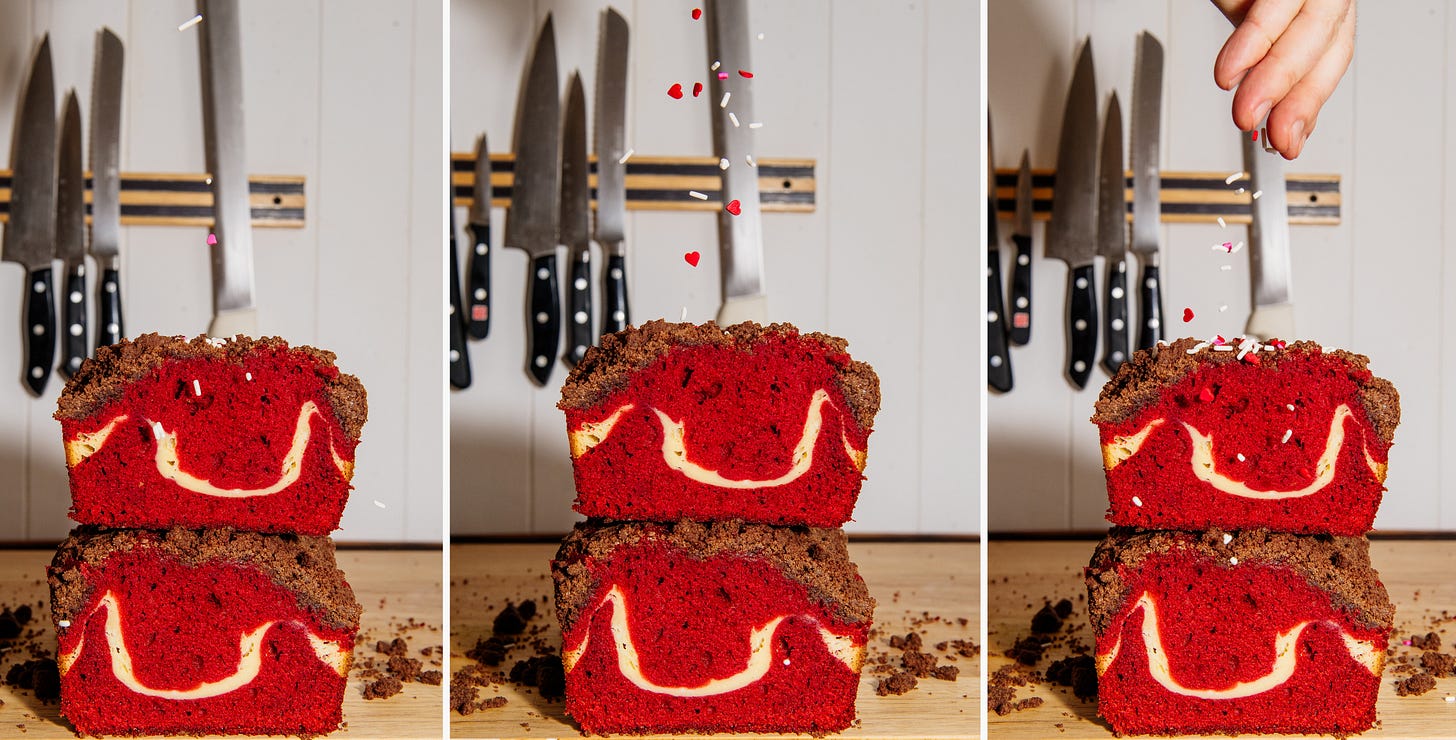
Red Velvet Bread
Filling
4 ounces Philadelphia cream cheese, room temperature
1 egg
¼ cup granulated sugar
1 tablespoon flour
½ teaspoon salt
Cake
1 stick butter, room temperature
2 tablespoons canola oil
2 tablespoons cocoa powder, I used Hershey’s
1 ½ cups flour
¼ teaspoon baking soda
2 teaspoons salt
1 ¼ cups granulated sugar
3 eggs
1 teaspoon vanilla extract
½ teaspoon white vinegar
½ cup buttermilk
1 teaspoon red gel food coloring
Crumb Topping
¾ cup flour
⅔ cup dark brown sugar
2 tablespoons cocoa
1 teaspoon salt
5 tablespoons butter, room temp
Filling
In the bowl of a stand mixer using the paddle attachment, beat the cream cheese until smooth. Add the sugar, beat to incorporate.
Add the egg, and beat to incorporate. Scraping the sides and bottom, beat until smooth.
Add the flour and salt, and beat until smooth. Scrape into a small bowl and set aside.
Cake
Using the same bowl and paddle as the filling (no need to wash), beat the butter and sugar until light and fluffy.
Add the eggs one at a time, beating in between. Add the oil, vanilla, and vinegar, and beat until homogenous and light.
In a medium bowl, sift together flour, cocoa, baking soda, and salt.
In a glass liquid measuring cup, mix the food coloring into the buttermilk.
On low speed, add the dries to the egg mixture in three additions, alternating with the buttermilk, starting and ending with the dries. Mix until the flour is just incorporated.
Scrape the sides and bottom. Finish mixing by hand to avoid overmixing.
Crumb Topping
Thoroughly combine the flour, cocoa, sugar, and salt.
Using your fingertips, rub the butter into the dries until completely combined.
Assembly
Spray a 9x5 loaf pan with pan spray, line with parchment, and spray again.
Spread half of the cake batter into the pan.
Top the batter with the cream cheese mixture, carefully spreading on top. Avoid spreading the cream cheese all the way to the sides.
Top the cream cheese layer with the remaining cake batter and smooth the top. Using a small offset or a table knife, swirl the batter in several S shapes, from one end of the loaf to the other.
Top with about ⅔ of the crumb topping, or as much as you’d like. Tip: squeeze the crumb mixture into some larger clumps as you top the batter, the larger clumps will be nice and crunchy when they’re baked off.
Place the loaf pan on a sheet tray, just in case. Bake at 325 degrees for 1 hour 20-30 minutes. A knife should come out cleanly from the center when done. Cool in the pan on a wire rack. Remove from pan when still slightly warm. If you’re using sprinkles, now’s the time to sprinkle.
Quick Bites:
I referenced a lot of great folks in this one and they have a lot of great books that I highly recommend you have in your collection, so here's a little list in order of appearance:
Irma S Rombauer’s classic The Joy of Cooking
Stella Parks Bravetart is honestly a perennial reference book for me.
The reprint of Freda DeKnight’s A Date with a Dish
Adrian E. Miller’s Soul Food: The Surprising Story of an American Cuisine, One Plate at a Time
Priya Krishna’s Indian-ish
David Tamarkin’s Cook90
Edd Kimber’s One Tin Bakes
A Piece of Cake is written by Bill Clark and edited by Andrew Spena. Photography by Hunter Abrams. Logo design by Brett LaBauve.




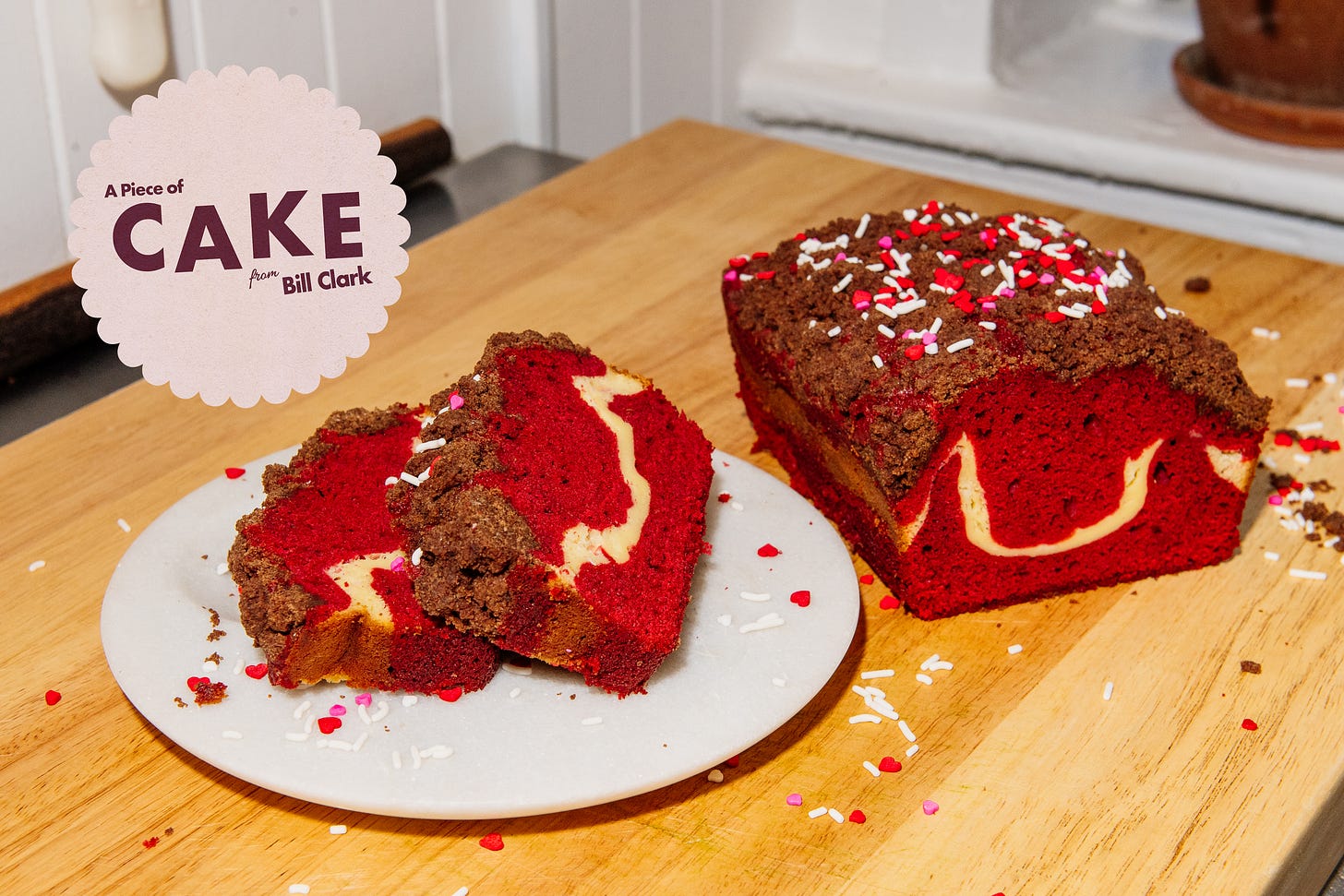
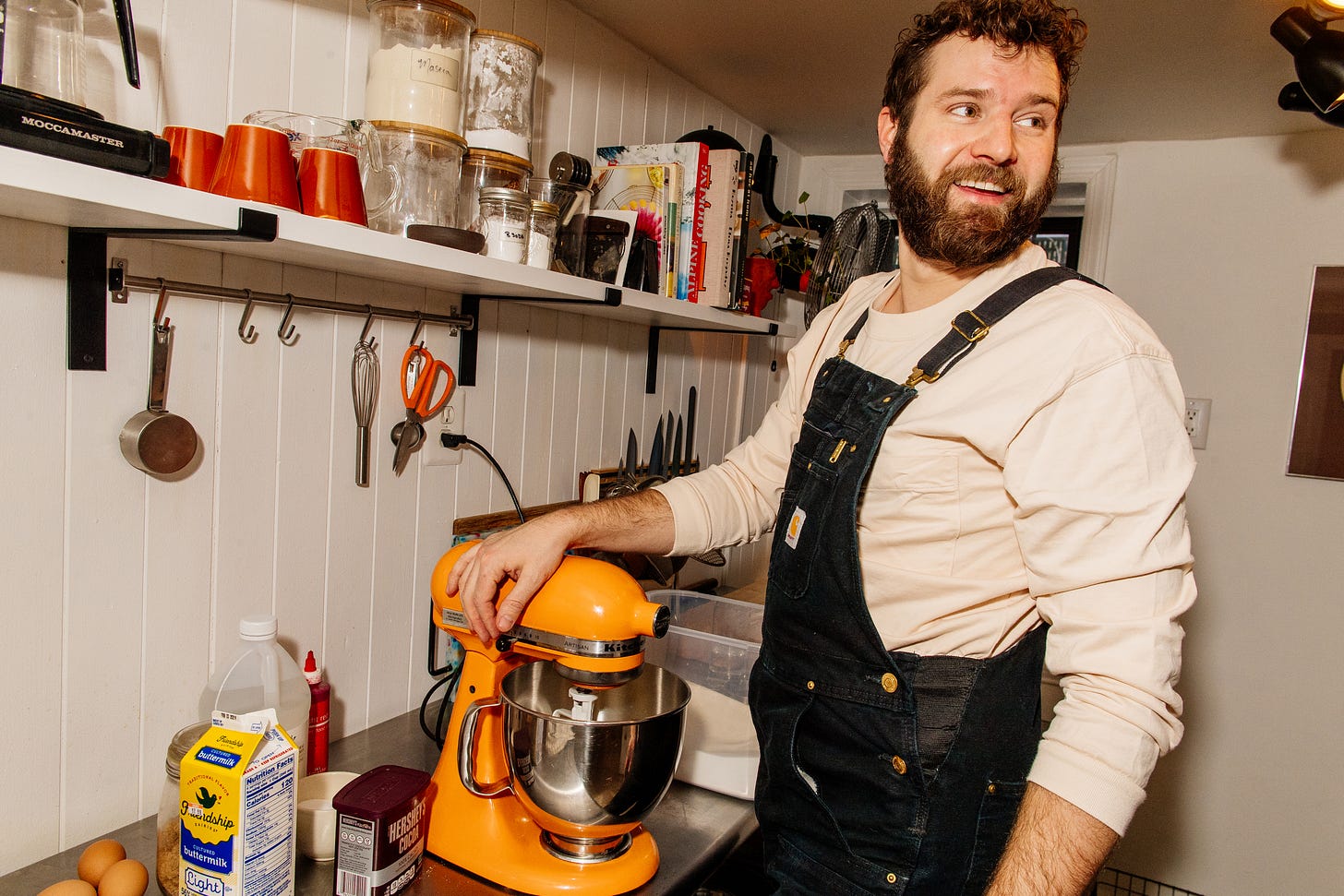
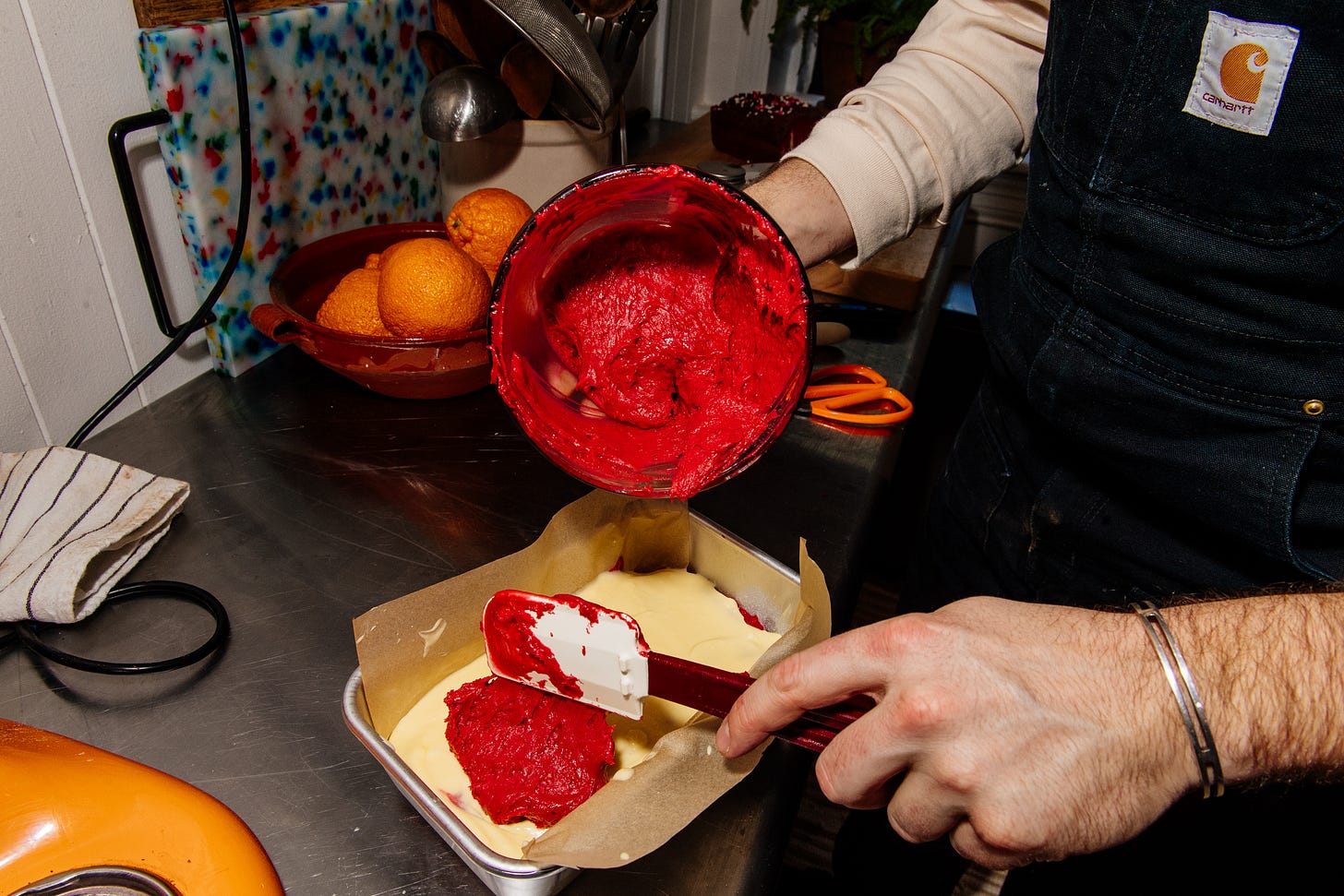

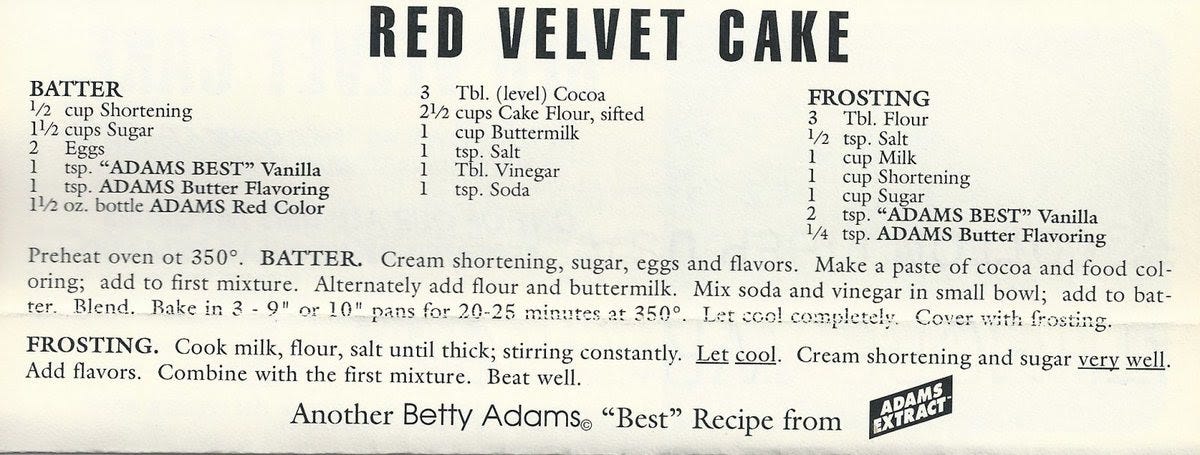

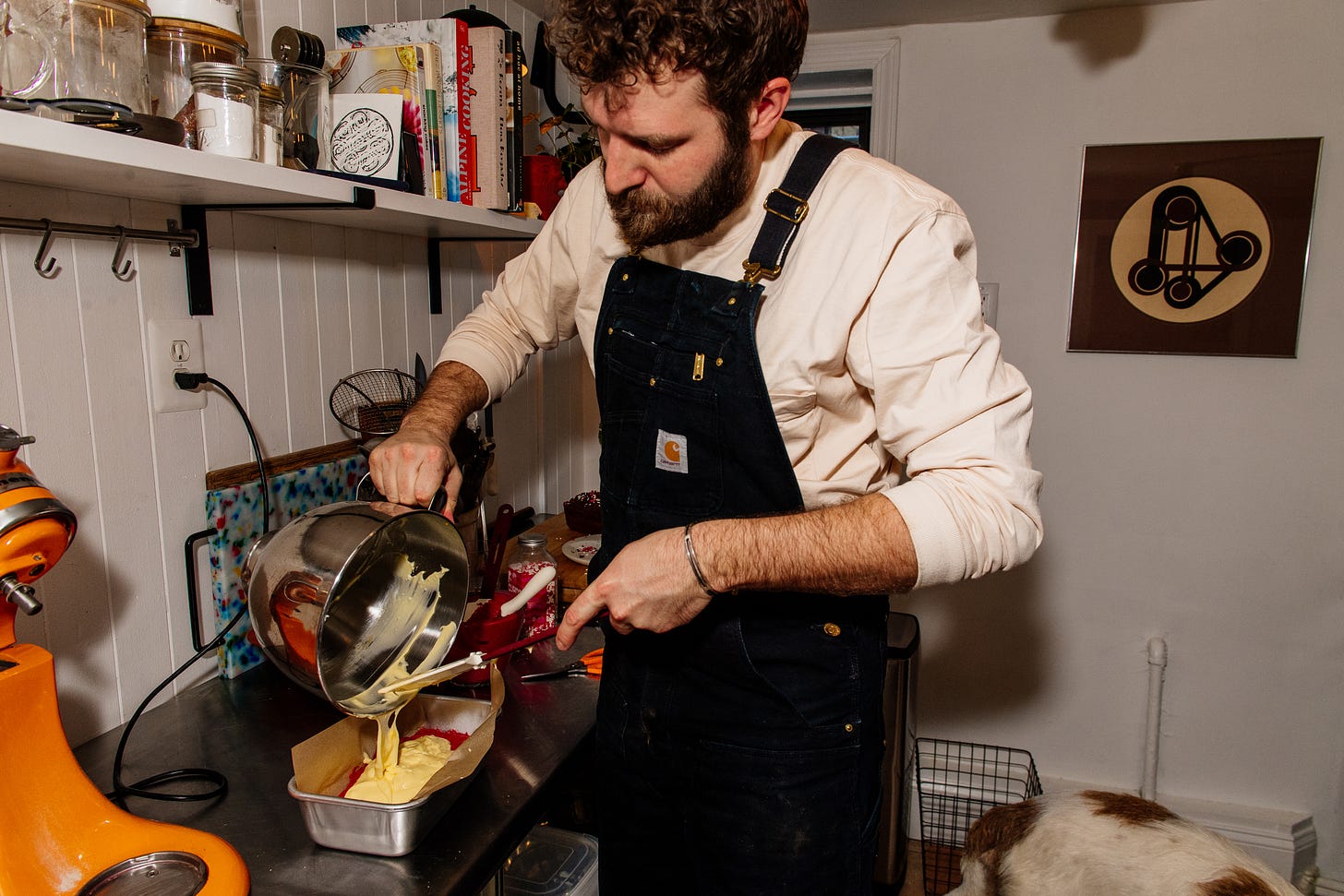

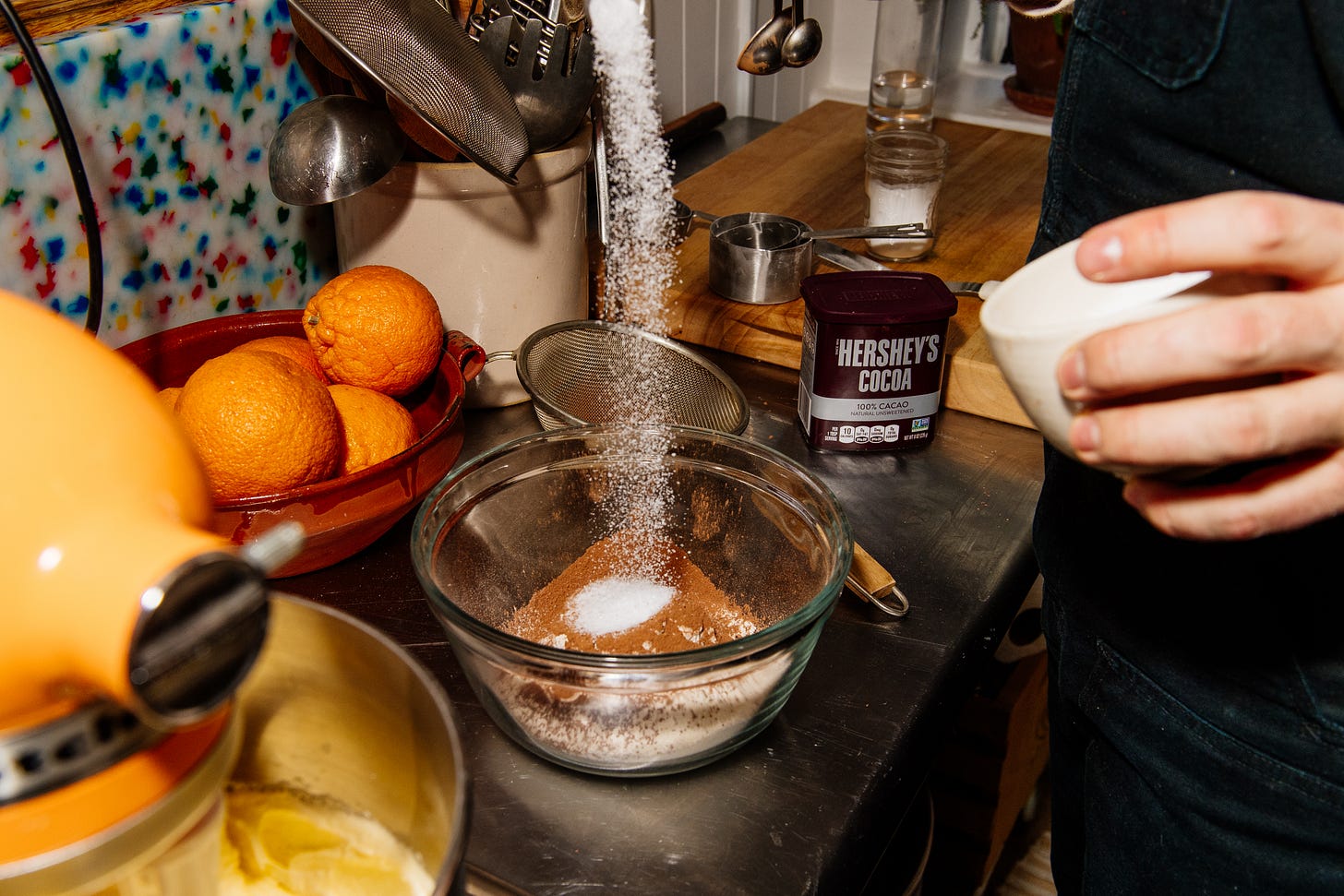
Hi! I just made this tonight - in the oven currently and can't wait to try it :) Same as Cory - this is the recipe that convinced me to become a paying subscriber. One thing I did notice in the recipe is that the ingredients are not written in 'use' order. I think it would make things a little easier when baking along so you don't potentially forget to add in any of the ingredients! Adding weights would also be a plus.
Hey, Bill! I just wanted to let you know that this week’s recipe and newsletter is the one that convinced me to become a paying subscriber. Your recipes are delicious—I’ve made both the free recipes you’ve published so far, to WILD success—and the impeccable research in this one sealed the deal. Can’t wait to make this in the coming week and bake my way through the backlog! Thanks so much for sharing these delightful recipes with us.